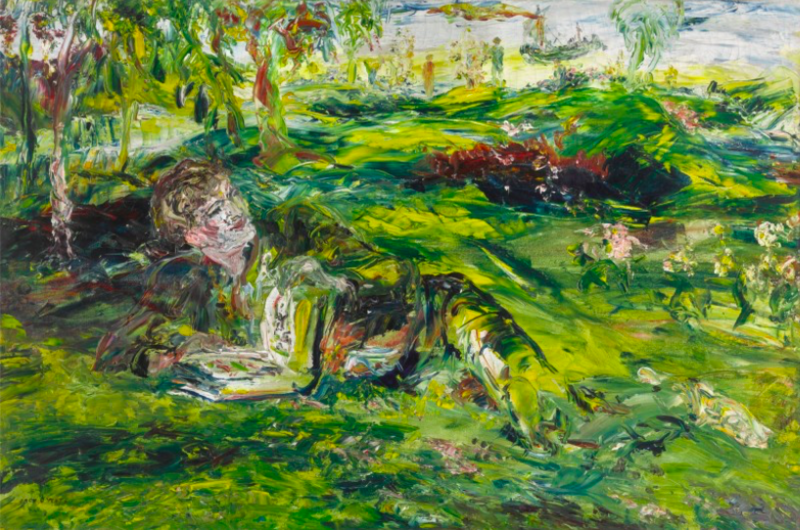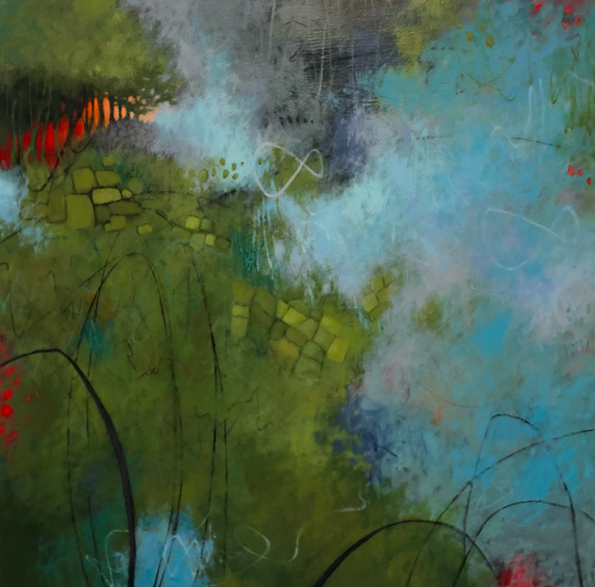In Tír na nÓg

Jack B. Yeats
In Tír na nÓg (1936)
Jack B. Yeats (Irish, 1871-1957), oil on canvas, The O'Brien Collection
‘It is not only delightful and original in its technique and in its superb craftsmanship, but there is a whimsical, imaginative quality in this picture that puts it in harmony with the most poetic conceptions of Tir na nÓg. Here we feel the essential Tir na nÓg, that dream world of loveliness and youth’.
EVENING HERALD, 20 APRIL 1936, ‘ROYAL HIBERNIAN ACADEMY EXHIBITION REVIEW’
In Tir na nÓg depicts a boy lying on a grassy bank, reading a book. He glances away from the pages, towards his vibrant surroundings of flowers, grasses and water. Above his head the cascading branches of a tree, create a natural canopy. Behind the reader, on the banks of the river, a fantastic scene of figures and ships takes place. Men and women stand on the shoreline or embark in their boats while an elegant, antiquated galleon marks the horizon line. This is reminiscent of other fantasy paintings of Yeats such as A Race in Hy Brazil (1937, Crawford Art Gallery) which also makes reference to a mythological island. It calls to mind the works of the French rococo painter, Antoine Watteau such as his Pilgrimage to Cythera, (1718-19, Charlottenburg Palace, Berlin). In this and other paintings by Watteau, noblemen and women travel to Cythère, the place where the goddess of love, Venus was said to have been born. The works suggest the transience of human emotions. The writer Samuel Beckett, a close friend of Yeats, noted the comparison between the two artists when he referred at the time, to Yeats’s work as becoming ‘Watteauer and Watteauer’ (Thomas MacGreevy, Jack B. Yeats - An Appreciation and an Interpretation, Waddington, Dublin 1945, p.15).
Tir na nÓg is the legendary land of youth, a mythological island, believed to be off the west coast of Ireland, to which according to folklore, the lovers Niamh and Oisín, eloped. W B. Yeats, Jack’s elder brother, described it in his Fairy Tales of the Irish Peasantry (1888) as the:
‘Country of the Young, for age and death have not found it; neither tears nor loud laughter have gone near it’.
One of W. B. Yeats’s most famous poems, The Wanderings of Oisín (1889), recounts the travels and adventures of Oisín through the mystical isles of Tir na nÓg. The subject clearly appealed to Jack Yeats also. In 1943 he painted another major work connected to the myth, A Blackbird bathing in Tir na nÓg(1943, Private Collection).
The boy in Yeats’s painting is not Oisín nor a Celtic warrior but a modern figure. He may be a self-portrait of the artist as a youth, according to Hilary Pyle (Jack B Yeats, A Catalogue Raisonné of the Oil Paintings, no.491). His body and face is sculpted out of thick paint and his smiling expression conveys the pleasure of this moment, when he is caught between the sensual delights of nature on a summer’s day, and the imaginative stimulation of a storybook filled with great tales and adventures.
The emotional intensity of the painting is conveyed through its rich colours, most notably the combination of blues and greens, a favourite mixture in Yeats’s paintings of the 1930s. The rich and varied application of pigment creates a capricious surface, full of movement and life. It emphasizes the tenuous position of the main figure, the youth, whose enjoyment of real and imagined form is only temporary. There is a suggestion that the pulsating landscape and myths will continue after he has gone. But the physicality of the vigorous brushwork and the power of the colour takes precedence over the narrative, forcing the viewer to engage in the sheer exuberance of the construction of the painting itself and its effects.”
-Dr. Róisín Kennedy (for Sothebys)
“For Yeats, the idea of eternal youth generally appears in his golden-headed boys, real boys of this world but symbol too of youth’s power not only to renew human life but also to perpetuate the human spirit into everlasting existence….”The picture is more a comment on the inspiration that the Land of Youth can instill than an attempt to suggest what the Land of Youth is. You are invited to enter into mind of the young boy reading his book, to understand the limitless potential of the imagination…”
-Hilary Pyle (Jack B Yeats, A Catalogue Raisonné of the Oil Paintings, no.491).
"The true artist has painted the picture because he wishes to hold again for his own pleasure - and for always - a moment, and because he is impelled... by his human affection to pass on the moment to his fellows, and to those that come after him."
JACK B. YEATS (Paris, 1922, Irish Race Conference speech)
Short Biography of Jack B. Yeats:
Jack B. Yeats was born in London on 29 August 1871, son of the portrait painter and illustrator John Butler Yeats and brother to the poet William Butler Yeats.
Though he was born in London but spent most of his childhood with his grandparents in Co. Sligo. Initially self-taught, Yeats took classes at various institutions including South Kensington, Westminster, Chiswick Art and West London schools of art. In the late 1880s he began his career as an illustrator, creating pen and ink drawings for journals and books, and cartoons for Punch Magazine under the pseudonym W. Bird. Yeats spent much of his time in Connemara and returned to Ireland full time in 1910, settling in Greystones, Co. Wicklow.
Hugely active on the Irish art scene, he participated in over 160 group shows during his lifetime, including regular appearances at the Royal Hibernian Academy (RHA), which elected him a full member in 1916. Yeats was also a founder member of the Society of Dublin Painters. He continued his graphic works for the Cuala Press (co-founded by his sisters, Susan and Elizabeth) and designs for the Dun Emer Press, but in 1925 decided to focus more on his own oil paintings, for which he is widely regarded today. Perhaps the most significant figure in 20th century Irish painting, he was heralded at Hugh Lane’s exhibition of Irish Art at Guildhall, London, as the ‘most distinctively Irish painter’.
(Bio Courtesy of Adams.ie)
Yeats was a friend of Samuel Beckett, who said of him:
“Yeats is with the greats of our time... because he brings light, as only the great dare to bring light,
to the issueless predicament of existence.”
For those who would like to learn more about the person that many believe was/is Ireland’s most important painter,
here is a link to a highly recommended biography on Jack B. Yeats by Bruce Arnold.
From: Marty Fahey, Curator, O'Brien Collection:
For this month’s entry, I have asked several amazingly talented friends to act as “Guest Curators” and to develop responses to this evocative Yeats painting. Below are the spectacular results, from Linda Aldrich (poet); Lillie Morris (artist) and Liz Knowles (musician/composer) which demonstrate, I feel, the wisdom in having such ”dialogues” between the branches of the arts. Each of these responses grant us a unique insight into the painting and, taken together with the narrative above, creates a truly kaleidoscopic experience of the painting. And, taken together, they are a testament to the power that art has to inspire and to move the imagination. In addition to illuminating the Yeats painting in their own unique ways, these three contributions also support each other quite memorably.
Poetic reflection: “In Tír na nÓg, Jack B. Yeats, 1936”, by Linda Aldrich
I’d like to think poetry is doing it, the far-off gaze
taking him out of the world or further into it,
looking at nothing and everything at once,
how when absorbed, time expands the moment,
puts him where he is and not there at all,
as he disappears into the clean photosynthesis
of a sunny day—the ocean, the boats, the people
on shore, the grass growing over and around him.
I know this can happen, how something catches us
up into the light of all that transpires, the moist green
of summer, the ocean’s glint, the words before words,
that first buzz fit of love in the heart. He does seem
happy, our young man, in this lush magma of paint,
and does he hold a book of color sketches, and so rises
from his own palette, from the center of his own dancing
landscape, a reddish smile, the dark flash of his eyes?
We see how young he is and are reminded of ourselves
when we knew how to begin, how to find our way back
into the beauty of making. The music, too, we remember,
though we must be still as moss to hear it.
Artistic interpretation: Tír na nÓg”, by Lillie Morris

Imagine an ethereal and aerial view of Yeats’ landscape as the imagination and the soul soars….
and the Infinity symbols “arrived” mysteriously for the artist while painting this-- of course, they are
perfect symbols in this context.
Musical interpretation:
“Sleeping in Tír na nÓg”, by Liz Knowles
Liz utilizes the painting and a magical old lullaby in Irish, *“Cuir a chodladh” (sung here by Elizabeth Cronin) as the starting point for her own response. And then, she weaves together a soundtrack that takes us on a journey into the spirit of the legend of Tír na nÓg, into Yeats’ painting and alongside both Linda and Lillie’s contributions as well -- true to the home page “mission statement” that appears on her own website which reads:
Seeking and creating elevated conversation
through music, marks, and meanderings, and
words, walks, and wanderings.
“Cuir a chodladh” (Put to Sleep)
*“The song is a lullaby, in which the child is soothed to sleep by having its feet washed and being given something to drink.
The seanduine (‘old man’) is the baby, the deach (‘drop’) is a drink of milk. The list continues with fresh meat, soup, a hen’s egg
and a pinch of butter!
The recording snippet embedded in this piece was originally recorded by the BBC on Aug 7, 1947 and was made available in a book and cd collection called The Songs of Elizabeth Cronin, Irish Traditional Singer, published by Four Courts Press, compiled and edited by Dáibhí Ó Cróinín.
After all, that drifting off, dreamy space in-between wakefulness and sleep is often the portal to the land of imagination.
Enjoy this journey inwards and off into the “land-scape, word-scape and sound-scape” that is Tír na nÓg.
Marty Fahey, The O’Brien Collection